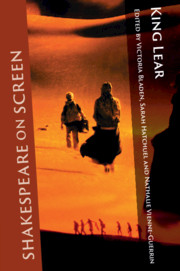Book contents
- Shakespeare on Screen: King Lear
- Series page
- Shakespeare on Screen: King Lear
- Copyright page
- Dedication
- Contents
- Illustrations
- Notes on Contributors
- Series Editors’ Preface
- Acknowledgements
- Chapter 1 Introduction: Dis-locating King Lear on Screen
- Part I Surviving Lear: Revisiting the Canon
- Part II Lear en Abyme: Metatheatre and the Screen
- Part III The Genres of Lear
- Part IV Lear on the Loose: Migrations and Appropriations of Lear
- Index
- References
Chapter 1 - Introduction: Dis-locating King Lear on Screen
Published online by Cambridge University Press: 10 September 2019
- Shakespeare on Screen: King Lear
- Series page
- Shakespeare on Screen: King Lear
- Copyright page
- Dedication
- Contents
- Illustrations
- Notes on Contributors
- Series Editors’ Preface
- Acknowledgements
- Chapter 1 Introduction: Dis-locating King Lear on Screen
- Part I Surviving Lear: Revisiting the Canon
- Part II Lear en Abyme: Metatheatre and the Screen
- Part III The Genres of Lear
- Part IV Lear on the Loose: Migrations and Appropriations of Lear
- Index
- References
Summary
The introductionoffers an overview of the various destinies of King Lear on screen, providing a reflection on the filmic objects themselves but also, through a review of the state of the art, on the ways they have been received by academia. The introductionjustifies the organization of the volume in four sections (Surviving Lear; Lear en Abyme; The Genres of Lear; Lear on the Loose), contextualizing the subsequent chapters and precisely pointing to their original contributions in the field. The concept of ‘dislocation’ is used to explore the ways in which the Lear films have worked on crisis, vagrancy, geographical displacement, migration (both in their following of the characters’ wanderings but also in their placing the play in other cultural environments) and on fragmentation (with dramatic motifs being dismantled and appropriated in ‘free’ adaptations). By revisiting ‘canonical’ versions,translations and free retellings in the Anglophone zones but also those beyond the US/UK axis, as well as ‘mirror’ metanarrative films, their genres and receptions through time, the introduction announces chapters that take part in the ceaseless investigation of what King Lear means and the way its ‘Learness’ continues to circulate and inform our contemporary cultures and especially to mirror the predicaments of today’s ‘unaccommodated’ men and women.
- Type
- Chapter
- Information
- Shakespeare on Screen: King Lear , pp. 1 - 30Publisher: Cambridge University PressPrint publication year: 2019
References
Works Cited
- 1
- Cited by



